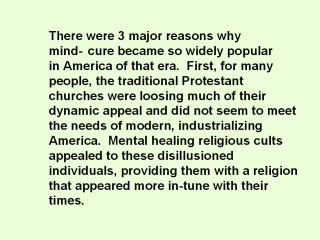 |
Secondly,
mind-cure sects appealed to a new class emerging in America, as, for the
first time, large numbers of people no longer were forced into long-hour,
hard physical labor jobs. This emerging middle-class had time to develop
psychosomatic diseases that readily lent themselves to mental healing
techniques. The pressures of a rapidly changing urban American society
created fears, phobias, and other emotional illnesses which traditional
medicine neither understood nor could treat, so this new group of “sick”
people in the U.S. eagerly turned to the mind?cure religions for answers,
just as many people today who face too much stress turn to meditation and
other self-control techniques for help. Finally, the
19th century traditional medical view of women and their physical and
emotional problems provided a large audience of disillusioned women for the
mind-cure approach to health care. |
